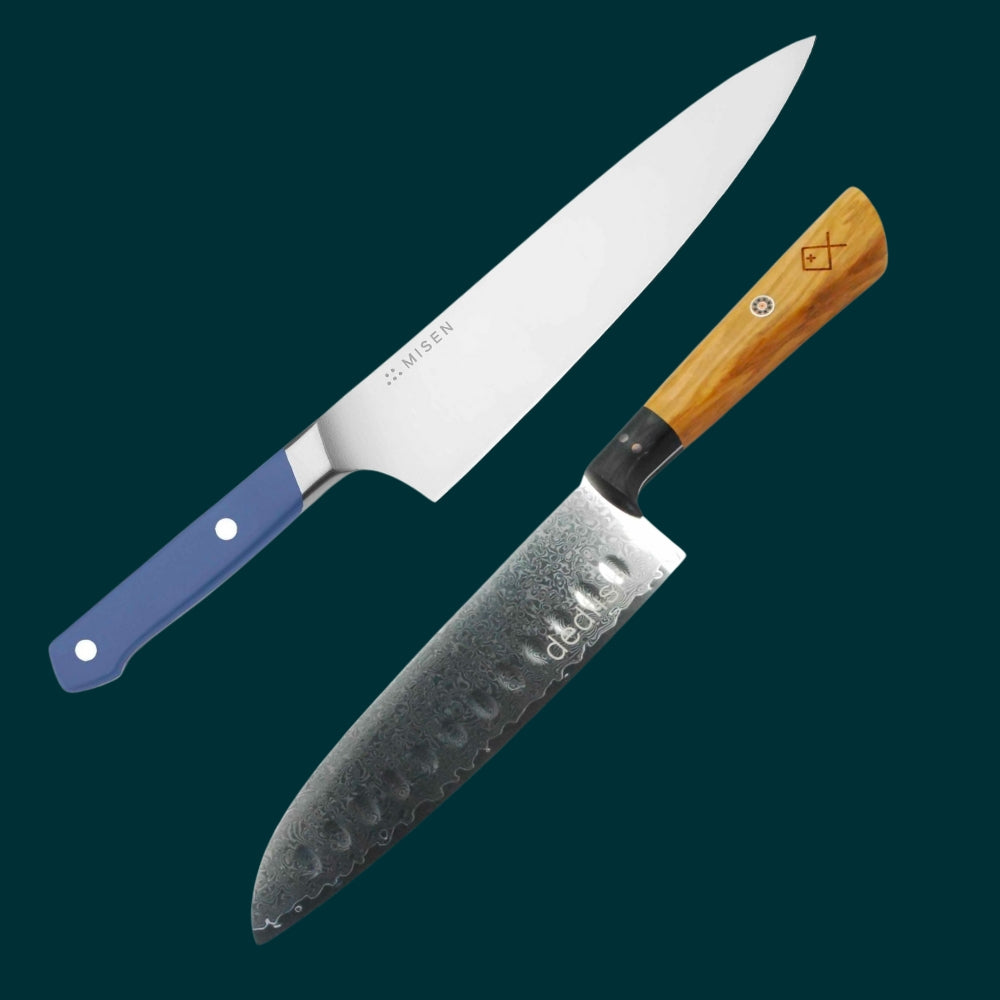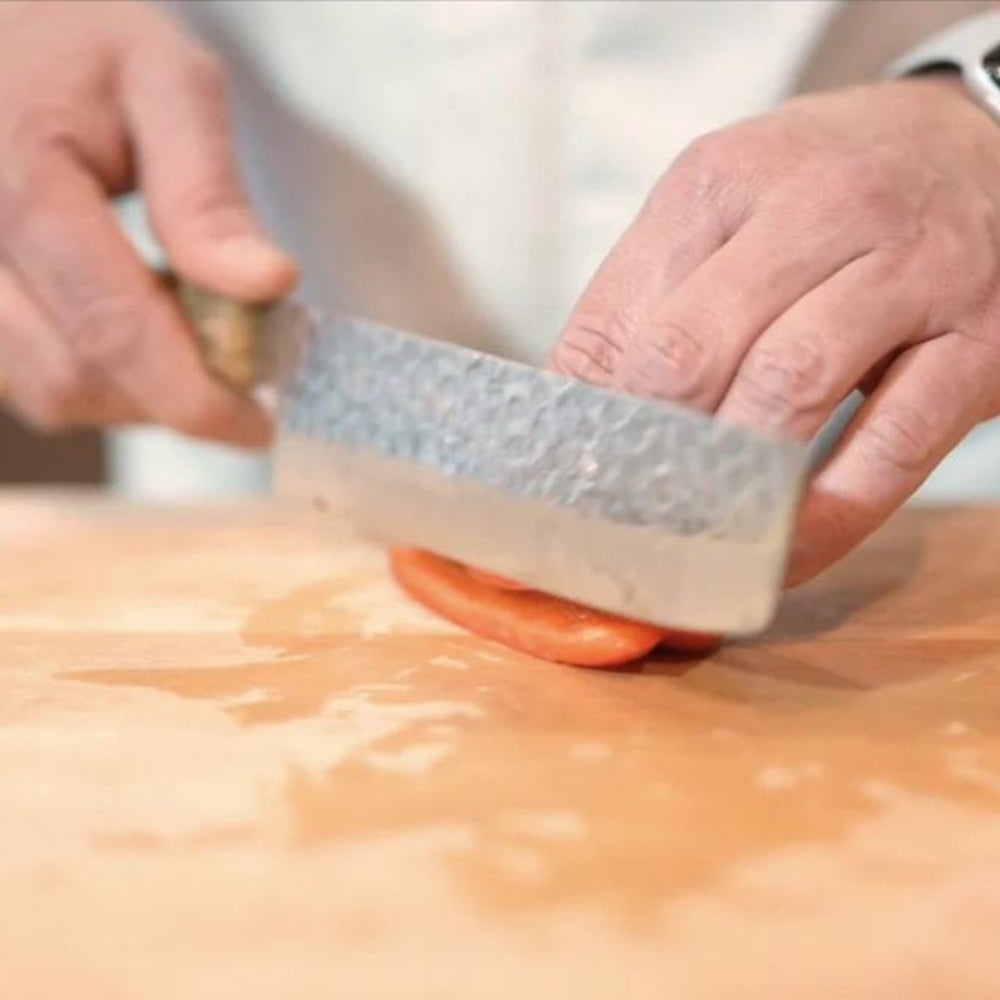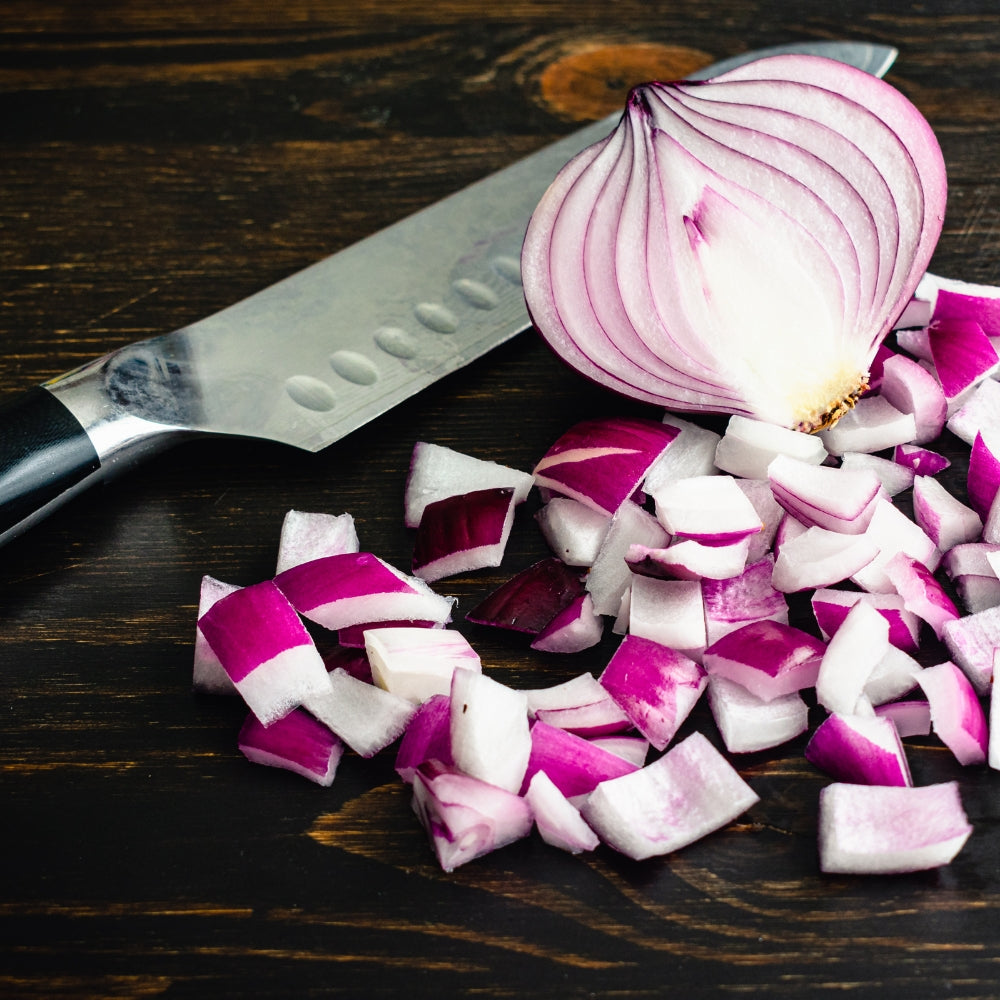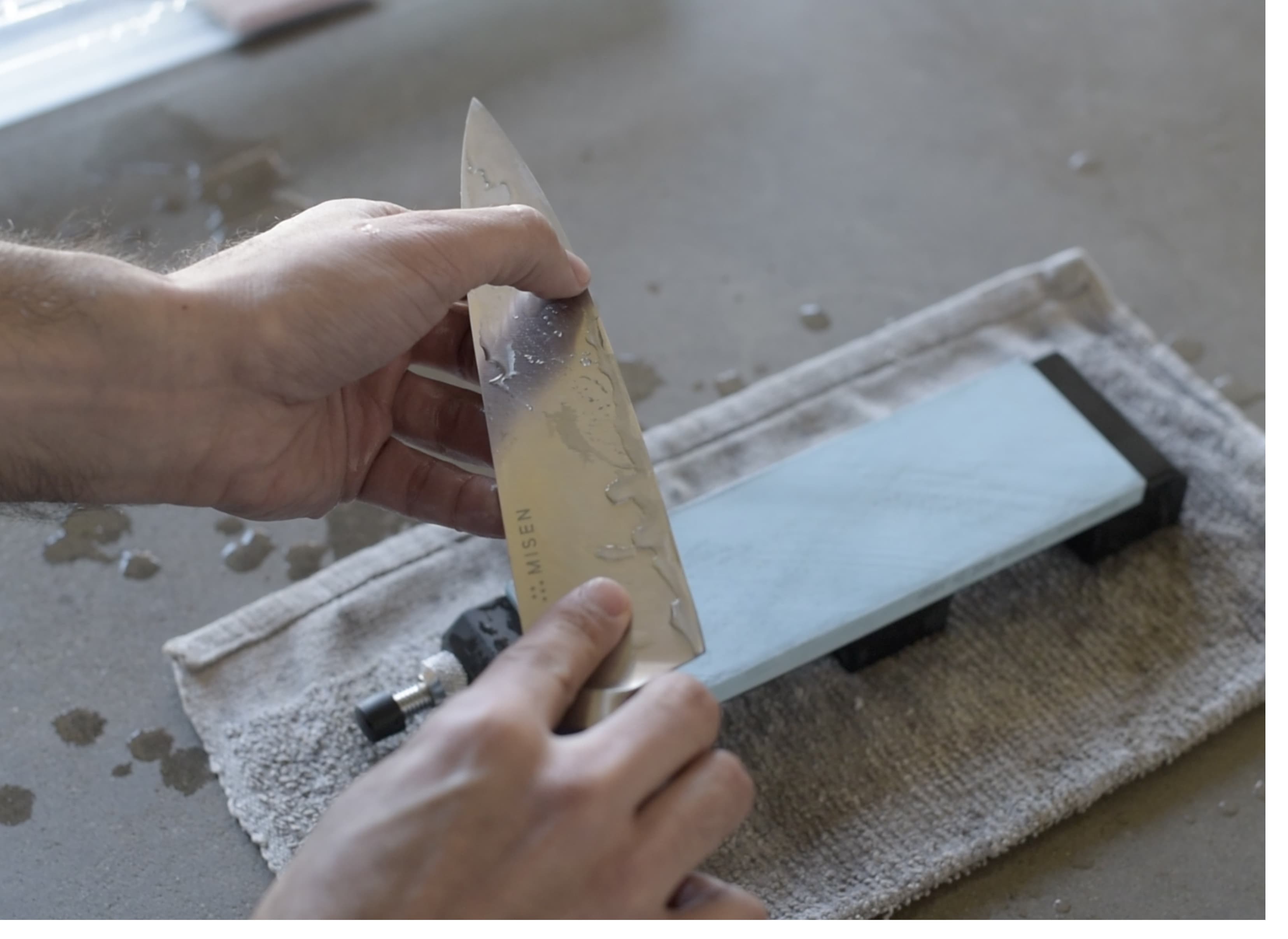
When to Use Santoku vs Chef Knife: A Home Cook's Guide
By Kenny Trusnik
Senior Food Writer at Pro Home Cooks
Ever found yourself puzzled about when to use a santoku vs chef knife? You're not alone. It's like standing at the crossroads of culinary artistry, unsure which path will lead you to that perfect slice or dice.
Santoku and chef knives are both kitchen powerhouses, each boasting unique features shaped by cultural influences from East and West. They’re as distinct as they are versatile, making it hard for home cooks and professional chefs alike to choose between them.
Whether it’s precision cutting tasks like julienning vegetables or creating complex cuts in meat, understanding when to use a santoku vs chef knife can make all the difference in your cooking experience. The choice often comes down to personal preference combined with an understanding of their individual strengths.
Ready to elevate your culinary game? Dive deeper into our top knives and discover the best in cookware. Explore now!
- Understanding Santoku and Chef Knives
- Blade Features and Cutting Tasks
- Knife Sharpness and Maintenance
- Knife Sharpness and Maintenance
- Cutting Techniques & Uses
- Cutting Techniques & Uses
- Comparison of Santoku and Chef Knives
- Your Knife Preference and Their Professional Use
- Personal Preferences And Professional Use
- FAQs in Relation to When to Use Santoku vs Chef Knife
- Conclusion
Understanding Santoku and Chef Knives
Every kitchen is incomplete without the presence of two key players - the Santoku knife and the Chef's knife. These are not just knives; they're culinary artists, each with their own flair and style. Their characteristics define them, making them distinct yet versatile for a variety of cutting tasks.
The Birth of Blades
If you trace back to where these blades were born, you'll find yourself in Japan for santoku knives and Germany along with France for chef’s knives. This isn't just geography we're talking about; it's a tale of how culture shapes tools that shape our food.
In Japanese cuisine, precision cutting holds high esteem, which influenced design features like shorter blade length and straight edge bevel on the traditional santoku knife.
From East to West - A Tale of Two Knives
Moving westwards towards French and German cuisines that demand robust usage, such as slicing bread or carving meat, required more broad-blade implements with curved edges. And voila. We got what we now recognize as standard chef’s knives. The cultural stories behind these tools show us why there are key differences between an inch santoku versus a chef's knife designed in Western kitchens.
This fascinating exchange has led to today's diverse cutlery scene where, depending upon individual needs, one might choose variations like an inch santoku or broad-blade chef's knife across kitchens worldwide.
Blade Features and Cutting Tasks
The features of a blade, such as its size, form and cutting edge type, can have an immense effect on one's culinary capabilities. Whether you're slicing vegetables with the precision of a seasoned chef or carving meat like an artisan butcher, these factors are crucial.
Shape Matters - Decoding Blade Designs
Take, for instance, the Santoku knife. Its sheepsfoot blade is wide yet lacks a tip – perfect when you're working on a cutting board filled with vegetables to chop. The rectangular design provides accuracy for complex cuts while maintaining control over each slice.
A standard Chef’s knife, on the other hand, features a broad curved edge leading up to a pointed tip. This makes it incredibly versatile in handling larger tasks, from slicing loaves of bread to tackling thick slabs of meat without losing any momentum during your cut.
Length & Edge - A Cut Above The Rest
Santoku blades may be shorter than traditional Japanese chef knives, but they boast thinner steel construction, which gives them unmatched agility during use. If your kitchen routine involves detailed vegetable prep, then this inch santoku straight-edge could become your go-to tool.
Chef's knives, though, tend to have thicker blades built for heavy-duty cooking scenarios across various ingredients, including tougher meats; hence their longer lengths and bevel edges come into play here. Choosing between these two depends heavily on what dominates your culinary exploits: intricate veggie chops or robust ingredient handling?
Next, we delve deeper into how sharpness impacts performance alongside tips on maintenance.
Knife Sharpness and Maintenance
It's crucial not just to have high carbon steel variants at your disposal but also to know how best to maintain their sharp edges so they last long before needing professional touch-ups.
Every blade tells a story. The Santoku knife, with its wide sheepsfoot blade and thin steel construction, is your perfect partner for detailed vegetable prep. Meanwhile, the Chef's knife, boasting a broad curved edge and thicker blades, tackles heavy-duty cooking tasks like slicing bread or thick slabs of meat. So pick your kitchen companion based on what dominates your
Knife Sharpness and Maintenance
Akin to the underappreciated carbon steel pans, high carbon steel blades of your kitchen knives may not be receiving the recognition they deserve. The truth is, these blades offer a combination of durability and sharp edge retention, similar to having multiple types of knife materials combined into one.
Sharpen Up Your Skills
Maintaining a knife set can sometimes feel like walking on thin ice; every action seems to carry the potential to harm your blade's sharp edge. Sharpening your knives requires finding the correct angle, typically between 15-20 degrees depending on the individual blade design. Santoku blades, in particular, have single bevels that reduce friction during slicing tasks, a feature that sets them apart from double-edged chef's knives.
The sharpening process may appear intimidating, much like handling reactive cookware such as cast iron or carbon steel. But fear not. It's simpler than it looks, and with practice, you'll become a pro.
Caring For Your Knife Set
- High heat washing? Not recommended.
- Metal tools scraping against the fine edges? A big no-no.
- Drying them improperly? That could lead to rust formation.
- Inadequate storage leading to accidental damage? Definitely avoidable.
All these actions pose threats similar to those faced by non-stick pans, potentially damaging their unique qualities over time. However, high carbon steel knives have an advantage. Just like how non-stick pans improve with use, maintaining a sharper knife will enhance its performance over time.
To ensure longevity, remember to hand wash both Santoku and Chef's knives immediately after use, then dry them thoroughly before proper storage when not in use. This will minimize wear-and-tear while maximizing their utility.
Cutting Techniques & Uses
Just as we've explored specific techniques suited for each type of pan material earlier, let's now delve into understanding cutting techniques best suited for different kinds of knives. These techniques include the rocking motion or julienning thin slices, among others.
Knife care is more than a cut-and-dry task. Like tending to carbon steel pans, it demands attention and finesse. Santoku blades' single bevels set them apart in slicing tasks while sharpening any knife requires the right angle—usually between 15-20 degrees. Steer clear of high heat washing, metal tools scraping against edges,
Cutting Techniques & Uses
Using a santoku or chef's knife, each offers its own benefits for the various kitchen tasks. From mincing garlic to dicing fruits, these knives excel at various tasks due to their distinct design features.
The Rocking Motion Cutting Technique
A common technique associated with the chef’s knife is the rocking motion. Picture this: your blade tip stays grounded on your chopping board while you maneuver the heel up and down - it's like an elegant dance between your hand and ingredients such as herbs or vegetables.
This method is perfect for mincing meat, slicing cheese into fine pieces, or creating delicate slices of garlic for a beautiful garnish on top of your favorite pasta dish.
Slicing With Santoku Knives
In contrast, using a santoku requires more of an up-and-down motion rather than rocking. Its shorter stature and flatter edge profile allow for precise straight cuts into hard produce like carrots or potatoes – making it ideal for julienning thin slices when uniformity is key in dishes.
A successful santoku cut demands less wrist movement compared to the rocking motion typically used with chef knives. This becomes handy during marathon food prep sessions where avoiding fatigue can make all the difference.
Differences In Kitchen Tasks: Meat Vs Vegetables
Now let's compare these two types of knives in kitchen tasks involving slicing meat versus chopping vegetables; each one brings something special to the table depending on what needs to be prepped.
If carving larger pieces of meat is a major part of your cooking routine, then the traditional western-style chef’s knife could be the right choice. Its curved blade ensures efficient separation at joints without damaging the tender flesh inside. On the other hand, if vegetable prep is a frequent occurrence, then the Japanese-inspired Santoku might serve you better. Its razor-sharp flat edge design handles delicate skin textures exceptionally well.
With the basics covered on how different cutting techniques impact performance with these two versatile tools, let's delve deeper into a direct comparison, detailing exactly which tasks each type excels at, from simple chops to complex cuts.
Master the art of slicing and dicing with the right knife for your culinary task. For a rocking motion cut, like mincing meat or finely slicing cheese, grab a chef's knife. Its curved blade allows an elegant dance between hand and ingredients. If precision is what you're after in hard produce, then go for a santoku - its straight edge makes uniform
Comparison of Santoku and Chef Knives
In the world of kitchen tools, Santoku and chef's knives are titans. Each knife has unique features that make it indispensable for different cutting tasks. However, when it comes to specific jobs like disjointing meat or julienning veggies, they excel in different ways.
The Art of Slicing Vegetables: A Tale of Two Blades
A traditional Japanese santoku knife is a marvel when it comes to slicing vegetables. Its slender blade and rectangular profile enable complex cuts like juliennes or paper-thin slices for salads. On the other hand, a standard chef's knife is designed for efficiency. Its curved edge allows for efficient rocking motions, making it ideal for chopping vegetables quickly.
Cutting Meat: Traditional Japanese Santokus vs Versatile Standard Chefs'
When it comes to carving meats, the robustness and pointed tip of a western-style chef's knife may be more suitable than the precision tool that is the santoku. However, both knives can handle most food preparation scenarios admirably.
There are key differences between santokus and chef's knives that may influence your preference depending on your cooking style.
Distinguishing Features Between Santokus and Chefs'
- Santokus: Typically have shorter blades with less curve, making them excellent for precise straight cuts like dicing onions or mincing herbs swiftly and cleanly.
- Chef's Knives: Usually longer and heavier, with upward-curving blades towards the tip that facilitate easier rock-chop action, useful for quickly mincing garlic cloves or roughly chopping root vegetables.
This comparison reveals how each knife excels at different types of tasks, from simple chops to intricate carvings, making both invaluable assets in any home cook's toolkit.
Your Knife Preference and Their Professional Use
We must not overlook another crucial factor when discussing knives – personal preferences among professional chefs and home cooks. Factors like hand size, specific cooking styles (Japanese versus Western cuisine), and others play a significant role in determining knife preference. So stay tuned.
Choosing between a Santoku and Chef's knife is like picking your favorite dance partner. Each has its rhythm: the Santoku, with its slender blade, makes precision cuts ideal for slicing veggies or dicing onions; while the chef's knife, with its curved edge, is perfect for quick chopping tasks. Your preference might hinge on cooking style or hand size.
Personal Preferences And Professional Use
In the culinary world, having the right tools is essential for both professional chefs and home cooks alike. For chefs and home cooks alike, a quality knife is an indispensable tool in their arsenal. The choice between using a santoku or chef's knife often hinges on personal preference and specific cooking styles.
The Choice of Professionals
In professional kitchens, there isn't one answer that fits all when choosing knives. Western-trained chefs often lean towards the versatile all-purpose chef's knife for its ability to handle various ingredients and techniques typical of Western cuisine.
On the flip side, those steeped in Japanese culinary traditions might gravitate towards santoku knives which emphasize precision cuts - think sushi or sashimi presentations where meticulous slicing is paramount.
The Home Cooks' Preference
Moving from bustling professional kitchens into more intimate home settings reveals similar trends but with additional considerations at play. For instance, if you're someone who enjoys experimenting with different cuisines at home, having both types of knives within arm’s reach could prove beneficial.
A Good Housekeeping article, for example, discusses how many prefer a western-style chef's knife due to its comfort during prolonged use compared to specialty options like cleavers or paring knives.
On another note, individuals who favor Asian-inspired recipes may find themselves reaching more frequently for santokus given their proficiency at fine slicing required for these meals.
Your Knife Choice Matters
In conclusion, regardless of whether you’re cooking professionally or simply love whipping up meals for family and friends in the kitchen, the right tools can make a world of difference. Therefore, whether you decide to go with the classic and versatile Chef’s Knife or the precise and nimble Santoku, it should be based upon your unique preferences and cooking style, ensuring maximum enjoyment and satisfaction each time you step foot into the kitchen.
When it comes to cutting and chopping in the kitchen, the type of knife you choose can make a big difference. Chefs trained in Western cooking tend to prefer chef's knives because they are versatile, while those with a background in Japanese cuisine often go for santoku knives for their precise cuts. However, it's important to remember that there is no one-size-fits-all solution. Whether you're an expert or simply enjoy cooking, finding the right knife for your needs is key.
FAQs in Relation to When to Use Santoku vs Chef Knife
When to Use Santoku vs Chef Knife: A Home Cook's Guide
When it comes to choosing between a santoku knife and a chef knife, it's important to consider the task at hand. Both knives have their unique features and optimal uses in home cooking.
What is a Santoku Knife Best Used For?
A santoku knife is best used for precision cutting tasks. It excels in finely chopping herbs, dicing fruits, and creating thin vegetable slices. With its sharp and narrow blade, it allows for precise and controlled cuts.
When Would I Use a Chef Knife?
A chef knife is a versatile tool that comes in handy for a wide range of kitchen tasks. From mincing garlic and chopping vegetables to disjointing large cuts of meat, a chef knife is your go-to option. Its curved blade and sturdy construction make it ideal for rocking cuts and slicing meat.
What are the 3 Types of Knives You Want to Have in Your Kitchen?
When it comes to building your knife collection, there are three essential knives you should have in your kitchen. Firstly, a chef’s knife offers versatility and can handle various tasks. Secondly, a paring knife is perfect for small-scale jobs like peeling fruits and precision cutting. Lastly, a serrated bread knife
Conclusion
When it comes to kitchen knives, it's important to understand the differences between a Santoku and a Chef's knife. These two types of knives have their own unique features and specialties that can greatly impact your cooking experience.
First, let's talk about the Santoku knife. This Japanese knife is known for its shorter length, typically around 5 to 7 inches. It has a flat edge and a slightly curved belly, which allows for precise slicing and dicing. The word 'Santoku' actually means 'three virtues' in Japanese, referring to its ability to handle three main tasks: slicing, dicing, and mincing.
On the other hand, the Chef's knife, also known as a French knife, is a versatile tool that is commonly used in Western cooking. It typically has a longer blade, ranging from 8 to 10 inches, and a curved edge. The curved edge allows for a rocking motion, making it ideal for chopping and mincing herbs and vegetables.
When it comes to maintenance, both knives require regular sharpening to maintain their performance. A sharp knife not only makes your cutting tasks easier but also ensures safety in the kitchen.
So, when should you use a Santoku knife versus a Chef's knife? It
Transform your kitchen experience with the best tools handpicked by Mike. Don't miss out on these essentials. Check out our top selections now!
TOP ARTICLES

Sourdough Baking School
Master the art of sourdough bread baking in the most comprehensive baking class on the internet. This class features over three hours of baking content to help you start your sourdough journey.
See More




